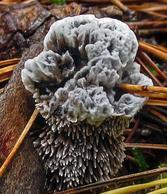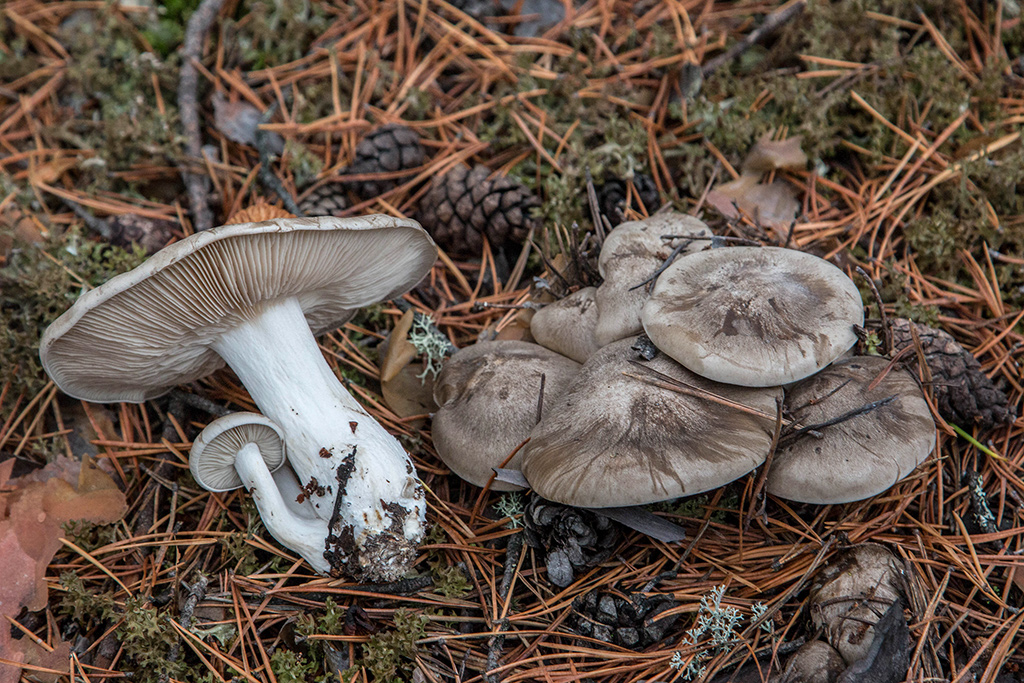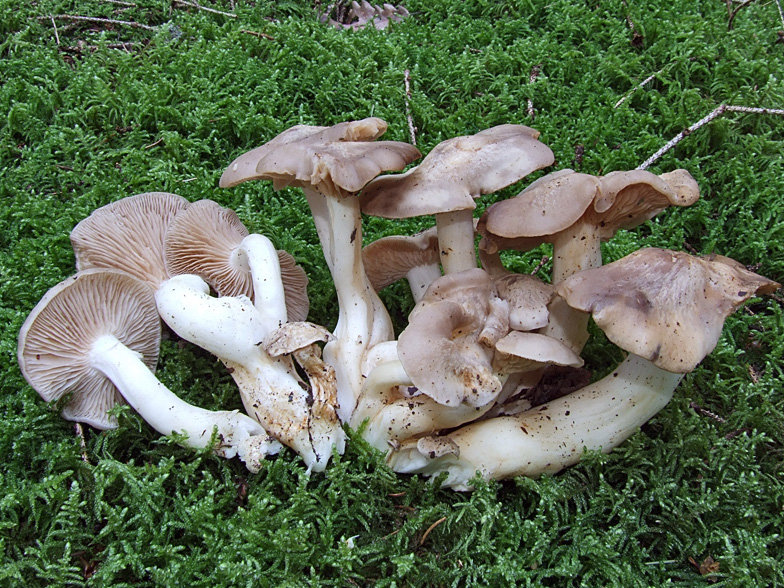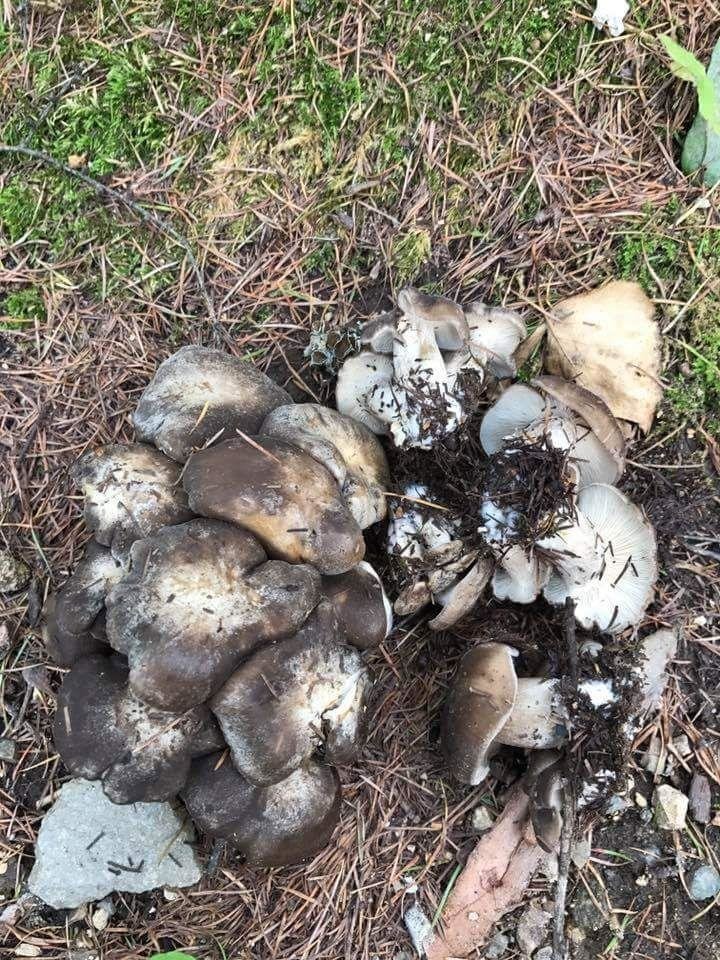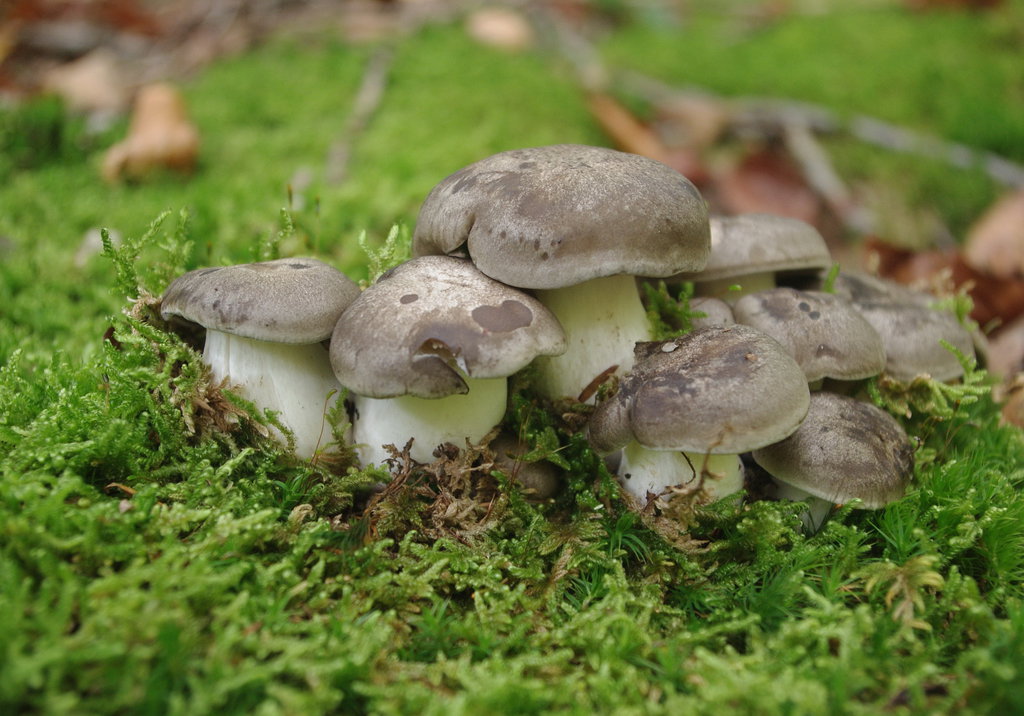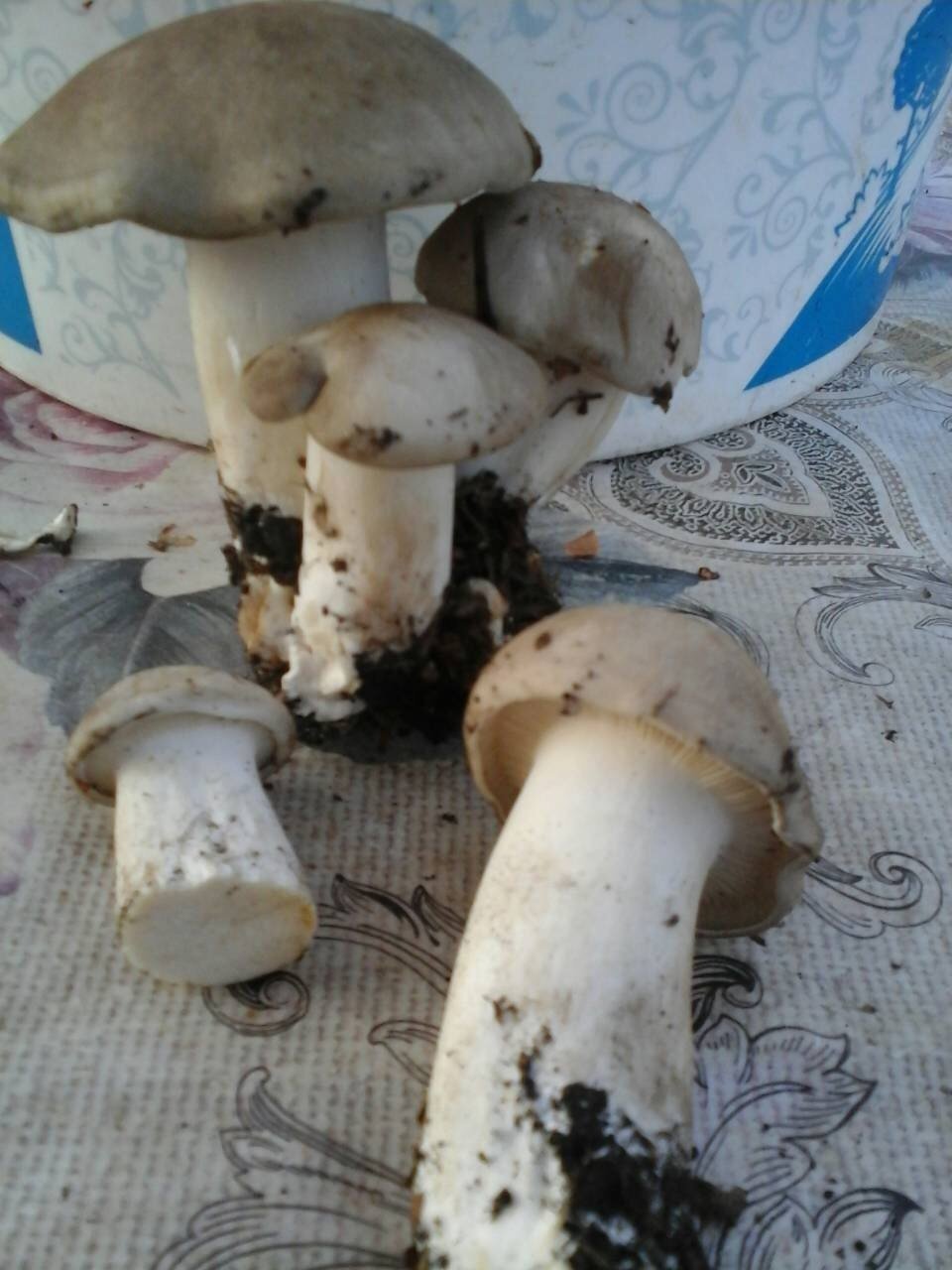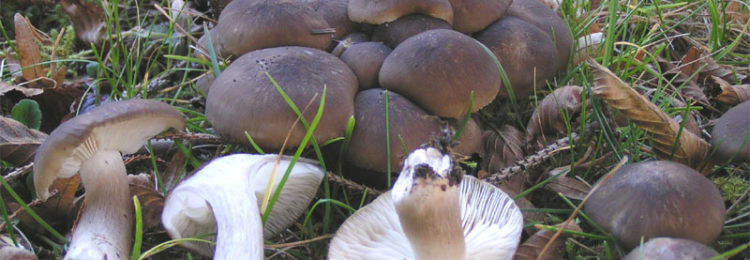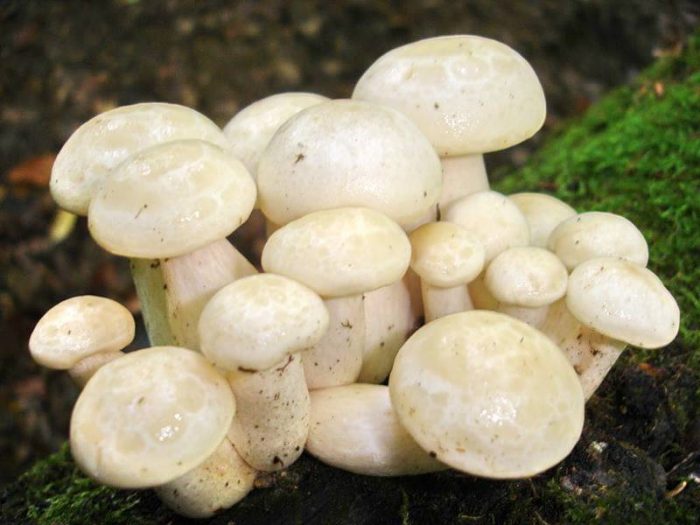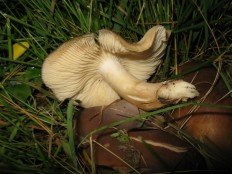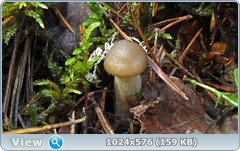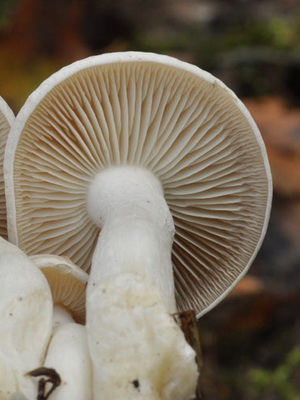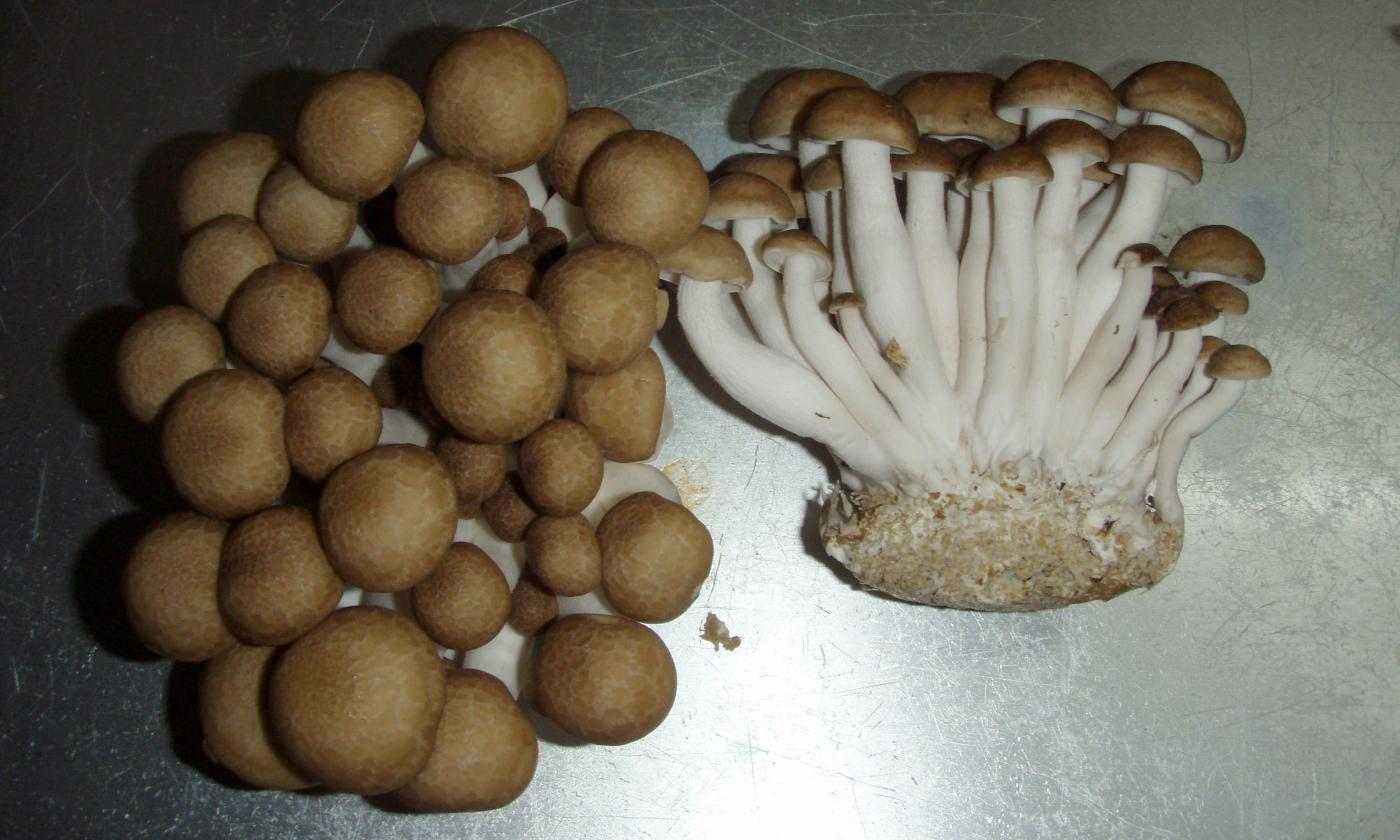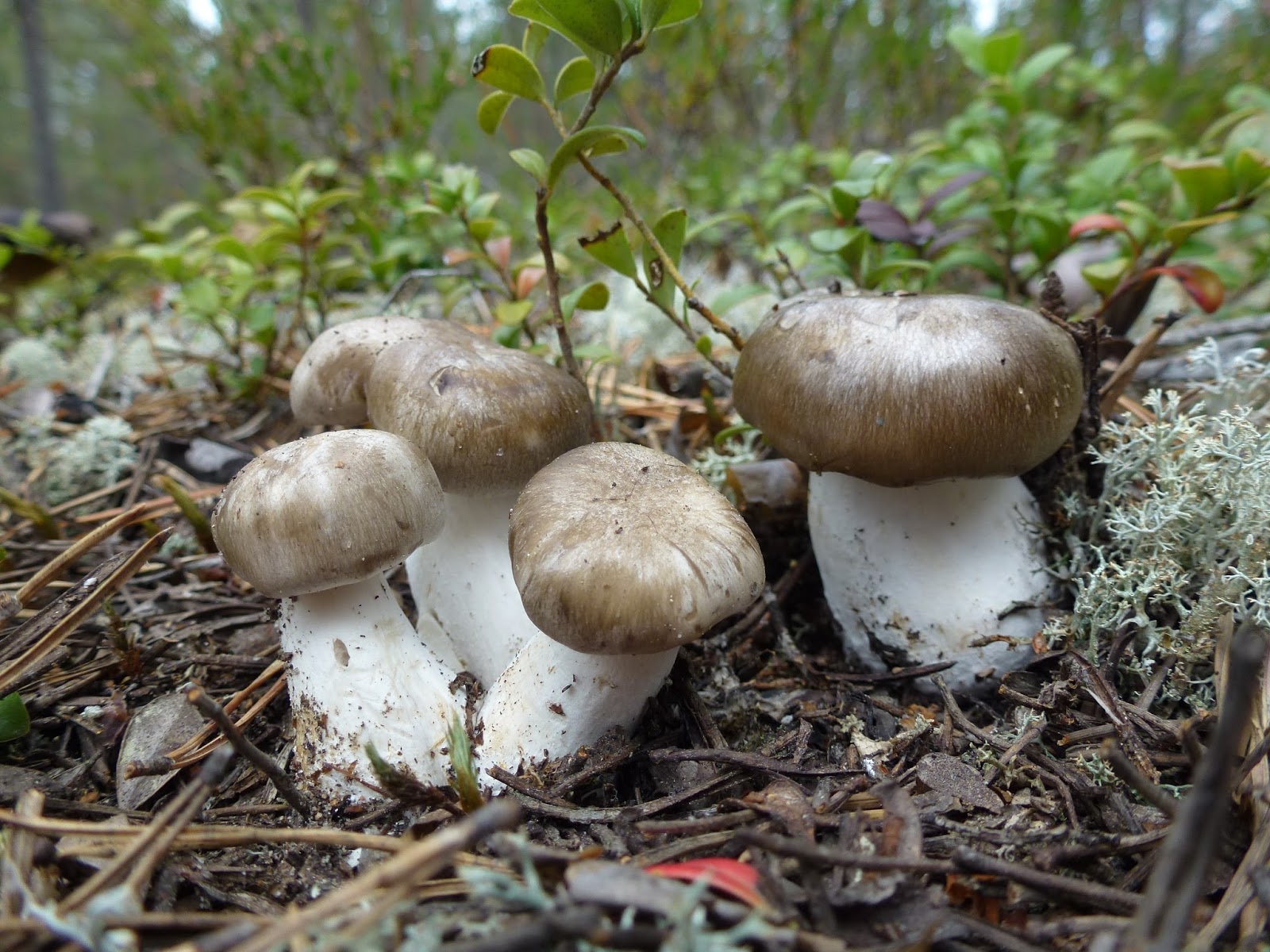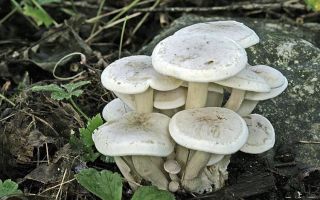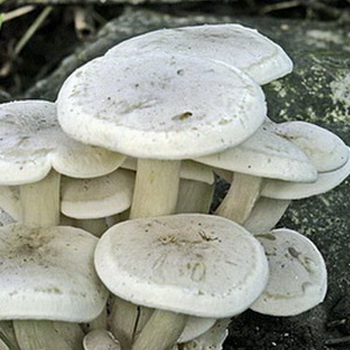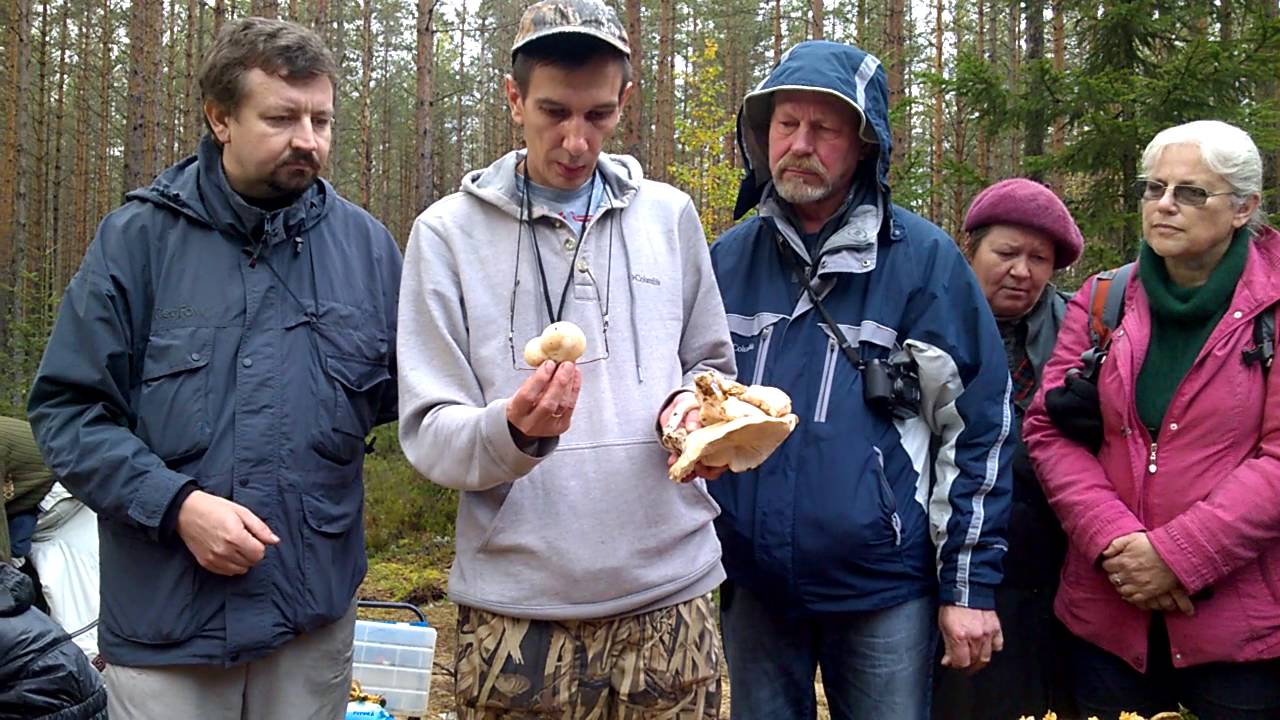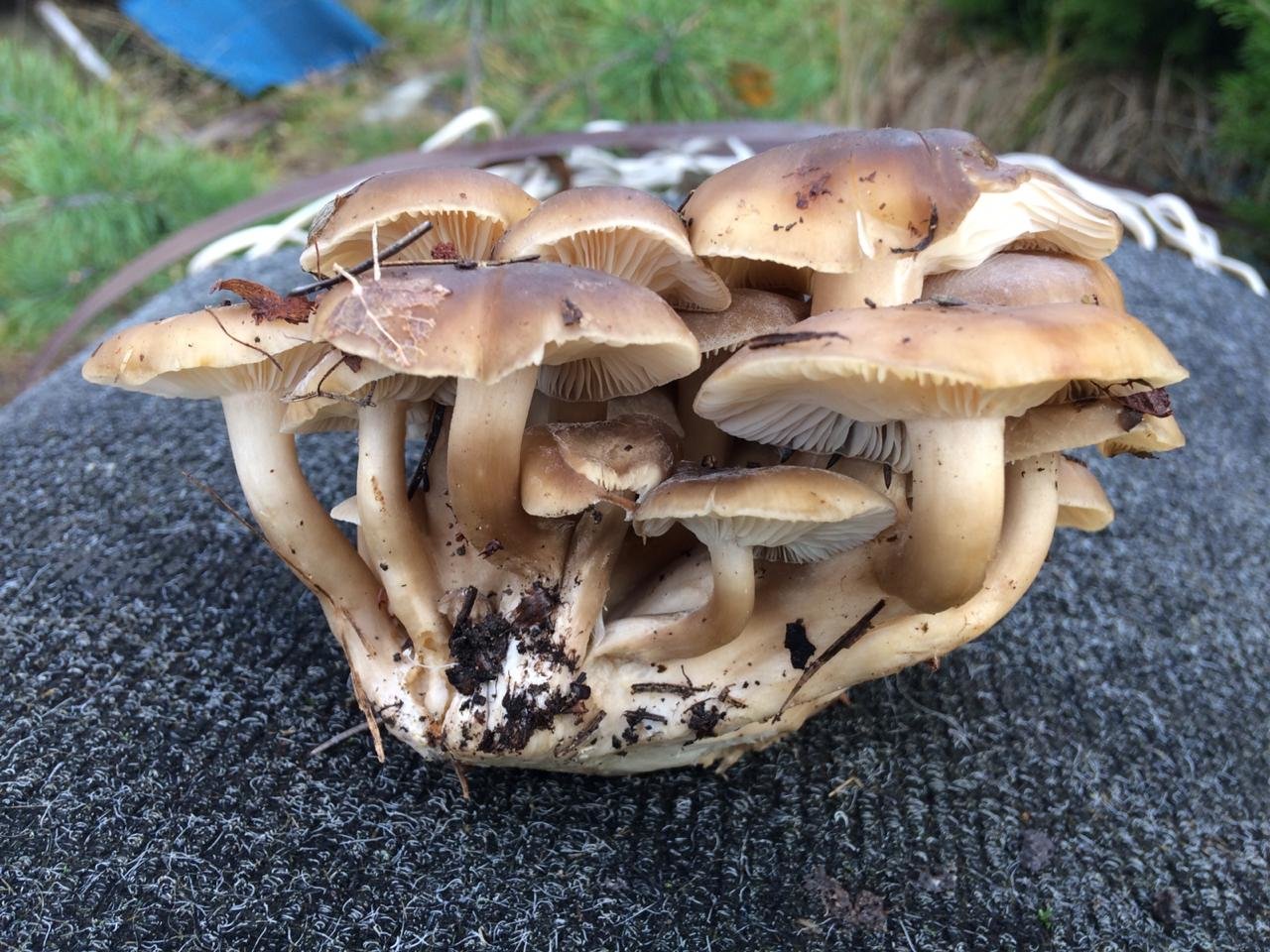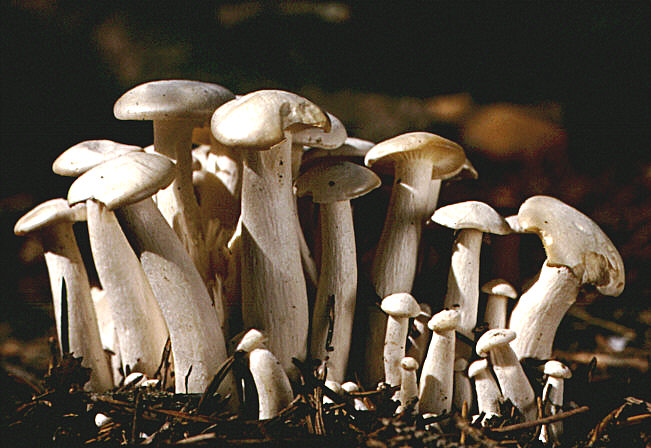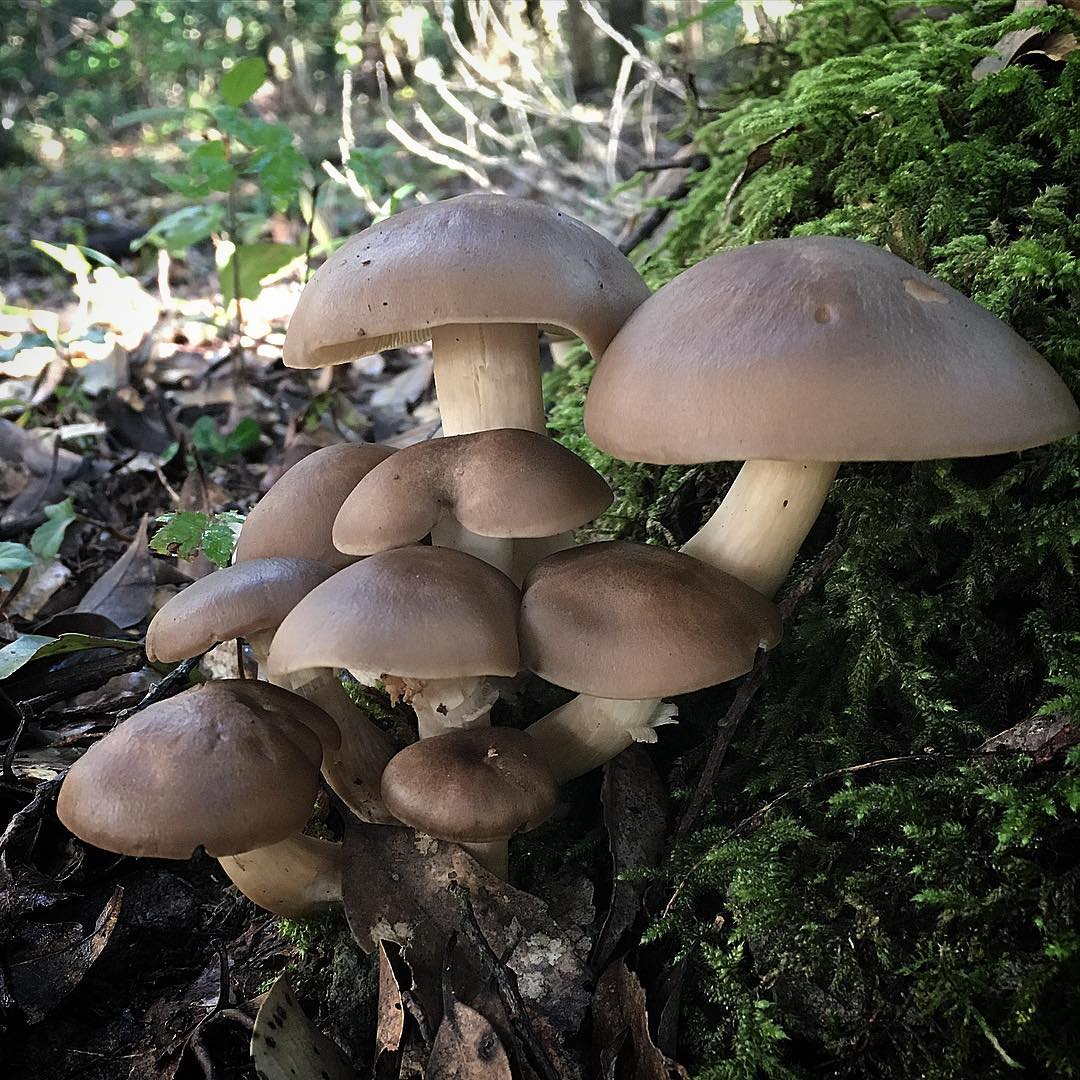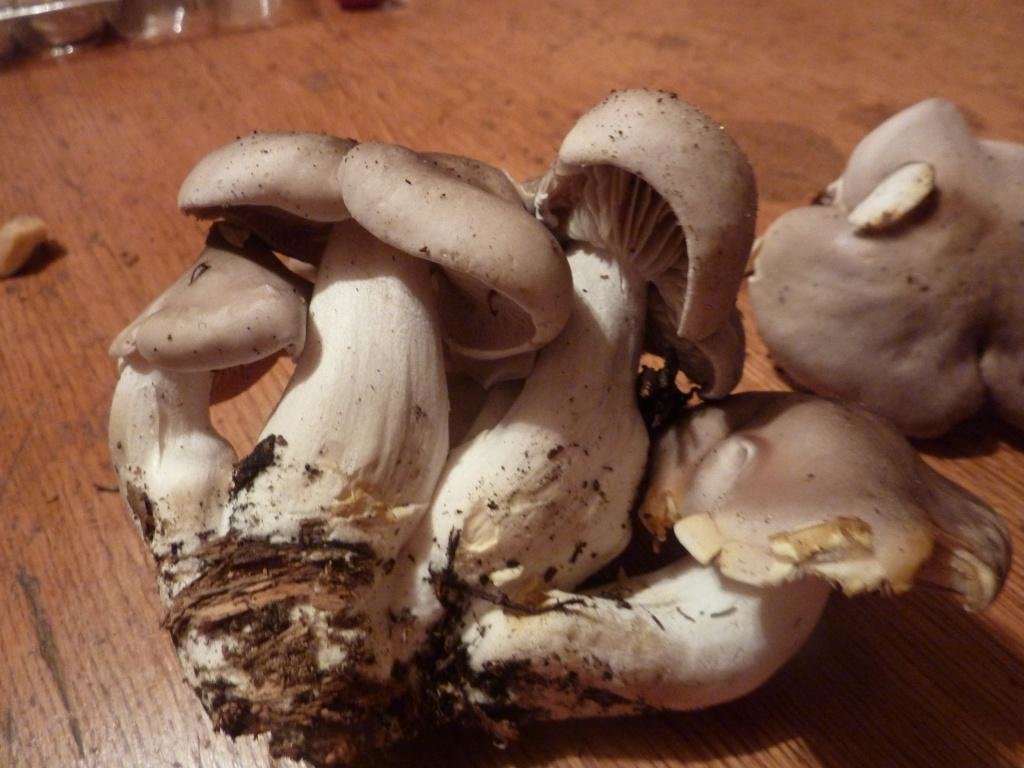Growing lyophillum elm at home

At home, elm lyophillum is grown from mycelium. For planting it, logs of birch, elm, elm, aspen are prepared at least 4-4.5 years old, about 30 cm in diameter, about 0.5 m long. The logs should be without branches, rot and other flaws.
Favorable period for sowing the mushroom: from April to October. Indoors, if it is possible to maintain the air temperature within 10-15 ° C, disembarkation is carried out all year round.
The logs are soaked in water for 2-3 days until the desired moisture level is obtained. After removing the logs from the water, the excess liquid is removed from them by keeping them for several days in a well-ventilated area.
In the logs prepared in this way, small holes are drilled with a drill (1 cm in diameter and 5-10 cm deep). They are staggered at a distance of 20 cm from each other.
Then, with cleanly washed hands or with gloves, special sticks with mycelium are placed into these holes. Further, the logs are packed in plastic bags, which prevents their infection and accelerates the development and growth of mycelium.
Logs with mycelium are placed in a shaded place with good ventilation and an ambient temperature of 20-25 ° C. The entire period of development of mycelium monitors the moisture content of the logs.
After 2-4 months, the mycelium completely fills the substrate. And six months later, the first harvest appears. The fruiting time depends on the hardness of the wood of the logs. For example, on soft woods, poplar, willow or birch, mushrooms are harvested for about four years. Hard varieties such as maple, mountain ash, beech bear fruit within 6-7 years. During the year, an average of 3-6 kg of mushrooms is harvested from each log.
Elm lyophyllum is an unpretentious mushroom. Even in dry summers, when other types of mushrooms practically do not grow, single lyophillums or clusters of mushrooms are found.
Lyophyllum smoky gray, Lyophyllum fumosum
Hat: From convex, cushion to flat in adulthood, often, in accordance with the growing conditions, irregular in shape, with wavy, oddly curved edges. Due to the same conditions, there is a large variation in size; within one joint, the diameter of the cap can vary from one to seven centimeters. The color is dirty gray, smoky or dull, which is why Lyophyllum fumosum earned its name. The surface is smooth, dry, sometimes covered with small scales, washed away by sediments. The pulp is grayish, moderately elastic, with a weak mushroom smell, without any particular taste.
Hymenophore: The plates are adherent with a tooth, relatively wide and frequent, in young mushrooms are light cream, later they turn gray.
Spore powder: White.
Leg: Smoky lyophyllum bears fruit in large aggregates (single specimens are rare), where legs of different lengths, thicknesses and curvatures form a monolithic “tuber”. The legs are mainly painted in light colors with a predominance of different shades of gray; the surface is smooth, with a powdery coating in dry weather. The pulp of the leg is light, highly fibrous.
Spreading: Smoky gray lyophyllum is found in dry pine forests, forming mycorrhiza, respectively, with two-pronged pine, from mid-summer to October. Not every year this mushroom is found often, but in good seasons Lyophyllum fumosum can bear fruit surprisingly abundantly, even forming "witch's rings" of massive growths.
Similar species: According to the views of the science of mycology, Lyophyllum fumosum is included in the complex of “accrete” lyophillums, which differ only in terms of growth and mycorrhiza-forming agent. In this series, one can distinguish a fused row, Lyophyllum connatum, and a crowded row, Lyophyllum decastes. On what basis some species of the genus Lyophyllum in Russian adaptation remain "lyophillums", while others turn into "ryadovki", is unknown to science.
Edibility: Unlike other "allied" lyophillums, Lyophyllum fumosum is considered a quite good edible fungus, which is obviously associated with not so hard pulp. However, due to the fact that it grows in the most abundant places, it is rarely harvested.
Author's notes: On dry sand, amid sparse moss and stunted pines, the lush thickets of smoky lyophyllum make some kind of suspicious impression. And, surely, not only on me. Hunters for saffron milk caps and boletus find a clearing densely overgrown with these strange mushrooms, tear off a splicing or two, pick, throw. Tell them that this is a quite decent mushroom in the preparation, they will not believe it and, perhaps, will be offended. It turns out that all the work is in vain.
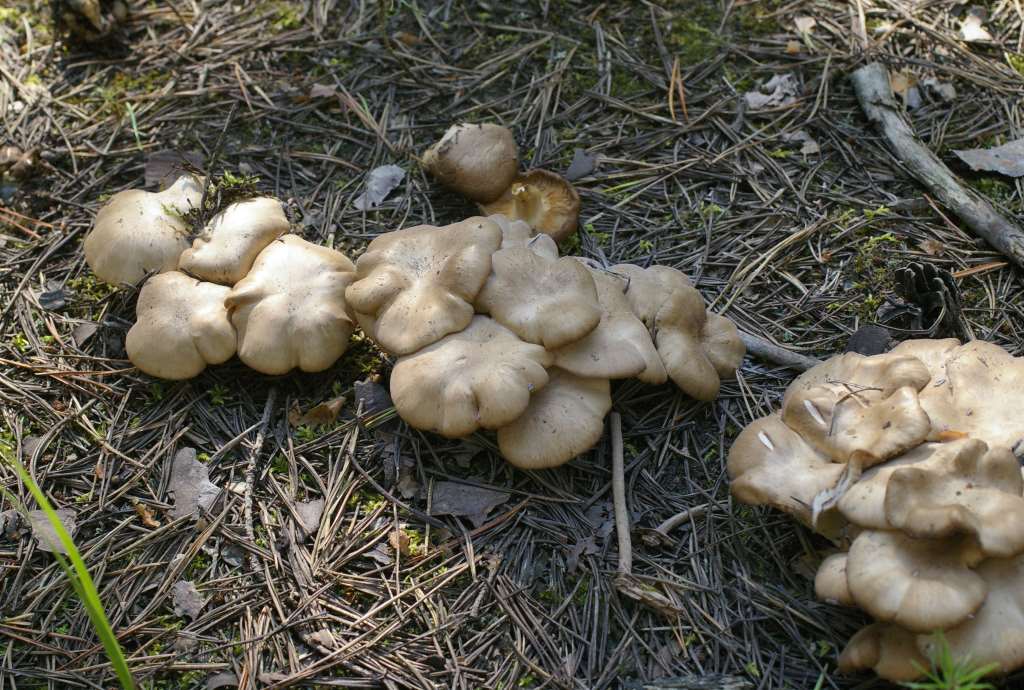
Fragment of the “Great Mushroom Wall”. The entire rampart that crossed the clearing between the pine plantations has not survived. Once it was solid, almost monolithic, but the invasion of the horde of boletus hunters could not be stopped.
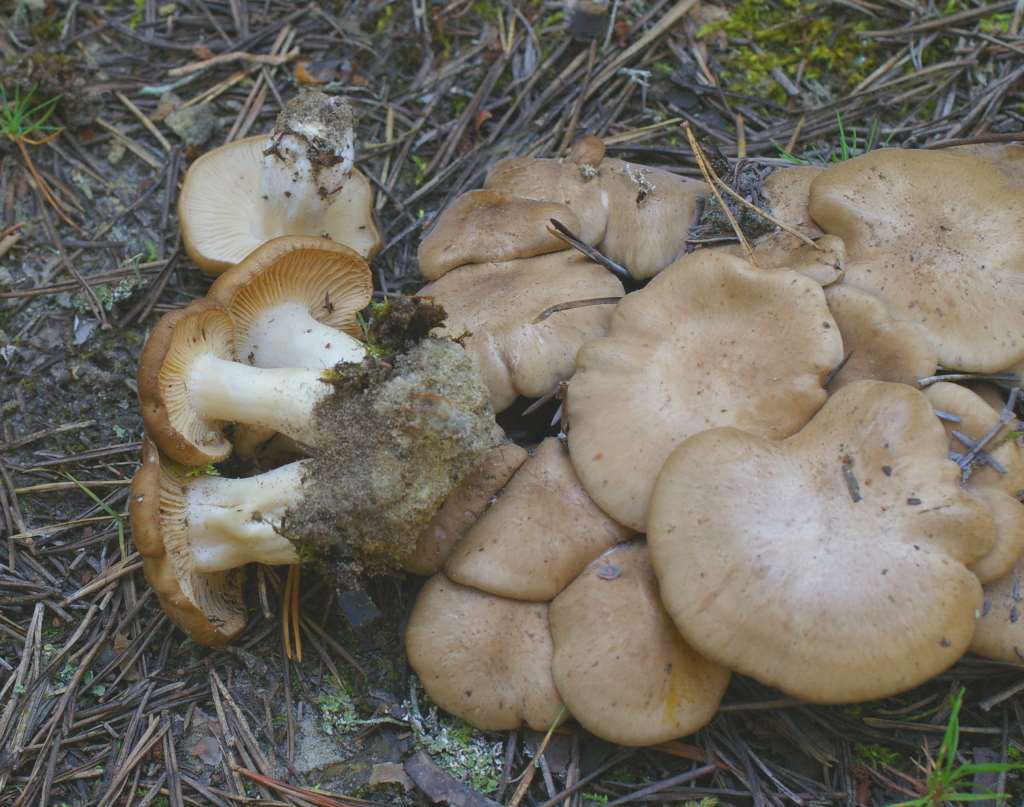
It is just that rare moment when the photographer does not feel guilty for the damaged plantings. Someone curious, and not alone, managed, so to speak, to prepare the drug for research. I believe that people who tear and scatter mushrooms they do not need are driven by some kind of high feeling. Even if they themselves do not know it.
Description and distribution of crowded rows, photo
Rows require special attention when collecting. Many varieties of these plentifully fruiting mushrooms, growing, as the name says, literally in rows, are inedible, and some are poisonous. One of the most valuable and certainly edible species is the crowded row.
Description
The specific name of Lyophyllum decastes or crowded row comes from the fact that this fungus, belonging to the class of agaricomycetes and the family of lyophilus, grows in more or less large, closely planted clusters, often united by fused legs and caps. A photo of this mushroom will become an additional guideline for its successful search.

Fruiting bodies have the following characteristic features:
- cap 4 to 10 cm in diameter, brownish-gray, darkening towards the center, smooth. Its shape changes with age from convex-hump-shaped to prostrate, with drooping edges. Often, in mature specimens, the cap cracks radially, and its edge turns upward in places;
- the plates are thick, somewhat descending, accrete with a tooth, lagging behind the pedicle in maturity. Their color changes from white to yellowish and grayish up to bluish-gray in old mushrooms. When pressed, the plates darken;
- spores are whitish;
- the pulp is light or brownish-gray, fibrous, elastic. Has a light powdery odor and a weak pleasant taste;
- the leg is cylindrical, up to 10 cm long, up to 2.5 cm thick, grayish, whitish in the upper part, darker gray-brown to the base, sometimes fuses the base with another leg.
Distribution and fruiting period
This type of rowing is common in the temperate latitudes of the Northern Hemisphere. It grows on forest edges, along the sides of paths, occurs in meadows, in parks and is not associated with any trees.

The fruiting season falls on the most end of August until the end autumn.
Similar types and differences from them
At the same time, that the row is crowded, species of the same family similar to it bear fruit:
- Smoky gray lyophyllum (Lyophyllum fumosum). Its fruiting bodies are ashy with a yellowish tinge, the flesh has a distinct fruity-floral odor. Grows mainly in mixed forests and spruce forests, edible after mandatory boiling.
- Armored lyophyllum (Lyophyllum loricatum) with a dark, blackish-brown cap is less common. It is edible, but less tasty than crowded.
- The fused row (Lyophyllum connatum) is colored much lighter - it is whitish with a bluish or gray-olive tint. Under the influence of a 10% solution of ferrous sulfate FeSO4 the flesh turns blue-purple and then pink. This mushroom contains lyophyllin, which is not destroyed by heat treatment - presumably a mutagen and a carcinogen.Therefore, the accreted ryadovka is currently considered poisonous.
In addition, the crowded row, if you do not study its description carefully, can be confused with the fruit bodies of other lamellar species, also growing in intergrowths - edible colibia (Collybia acervata) and meadow honey (Marasmius oreades), as well as marble honeydew (Hypsizygus tessulatus), which causes brown rot of wood.
Primary processing and preparation
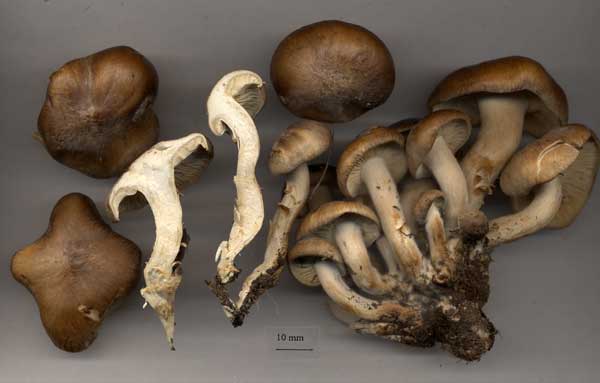
Despite the fact that the crowded row is definitely considered edible, it is recommended to boil it for 20 minutes. Mushrooms that have undergone such pre-processing are boiled or fried until tender. Moreover, they are delicious salted and pickled.
Healing properties
In addition to good taste, crowded rows have an immunostimulating effect. Their ability to inhibit the development of tumors, to reduce the level of cholesterol, insulin and blood sugar has been noted. In Asian countries, this species is bred as a raw material for antidiabetic and oncostatic agents, as well as drugs that enhance immunity.
The family of rowers in general and crowded rows in particular require a mushroom picker to have a good knowledge of all species characteristics. Only under this condition it is possible to collect not only a tasty, but also a curative September harvest of brownish-gray mushrooms.
Interesting Facts
- The family of ordinary mushrooms includes almost 2500 species of mushrooms. They are called "rows" because they grow very crowded, most often in rows.
- Before any cooking method, these mushrooms must be boiled for 20 minutes.
- Do not eat raw lyophillums, as this can cause stomach upset.
- It is best to salt the rows in the fall, during these periods the fruit bodies are the most elastic, dense. For salting, you need to choose young specimens, since the old ones can be tough.
The crowded row is a tasty, fragrant representative of the family of the same name. If you correctly identify and then process this mushroom, then you can not only treat your family and friends with a unique dish, but also make delicious preparations for the winter.
Types of fungus lyophyllum elm
Buna shimeji (Hypsizygus tessulatus)
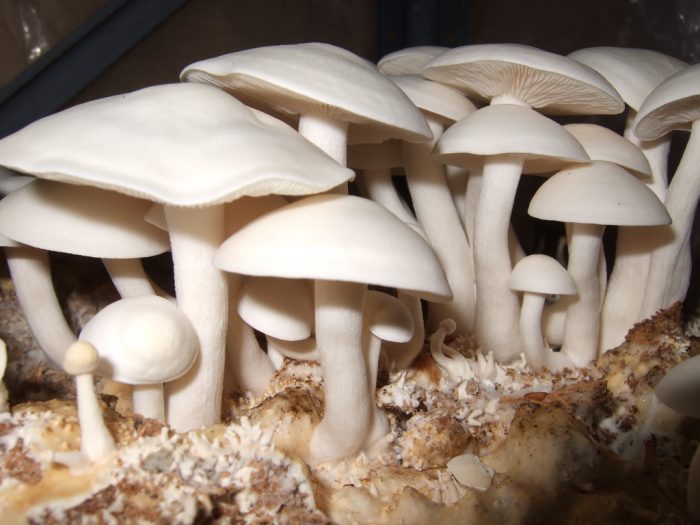
An edible mushroom native to East Asia. It is also grown in the temperate climate of Europe, North America, Australia. There are two types of mushroom: with white and brown fruiting bodies. The pulp of the mushroom is bitter, but when cooked, the bitterness goes away. The finished shimeji has a crunchy texture and a nutty flavor.
Matsutake (Tricholoma matsutake)
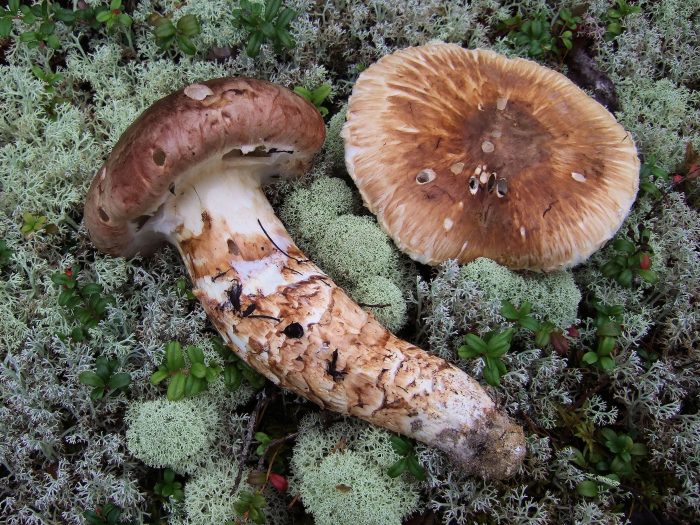
An edible mushroom that looks like elm lyophyllum. His hat is brown; in mature mushrooms, it cracks. The shape of the cap is round, the surface is dry. The pulp is white. The leg is long, clavate.
From Japanese the word "matsutake" is translated as "pine mushroom". This type of mushroom grows in groups in Asia, Japan, China, as well as in northern Europe and North America. Mycorrhiza forms with fir, oak and pine. Fruiting from September to October.
Lyophillum shimeji

Hon-shimeji
Until recently, it was believed that Shimeji Lyophyllum (Lyophyllum shimeji) is distributed only in a limited area covering the pine forests of Japan and parts of the Far East. At the same time, there was a separate species, Lyophyllum fumosum (L. smoky gray), associated with forests, especially conifers, some sources even described it as a mycorrhizal forming agent with pine or spruce, outwardly very similar to L.decastes and L.shimeji. Recent molecular studies have shown that no such separate species exists, and all finds classified as L. fumosum are either L.decastes (more commonly) or L. shimeji (Lyophillum simeji) (less commonly, in pine forests). Thus, today (2018), the species L.fumosum has been abolished, and is considered a synonym for L.decastes, significantly expanding the habitat of the latter, almost to “anywhere”.Well, L.shimeji, as it turned out, grows not only in Japan and the Far East, but is widespread throughout the boreal zone from Scandinavia to Japan, and, in some places, is found in pine forests of the temperate climatic zone. It differs from L.decastes only in larger fruit bodies with thicker legs, growth in small aggregates or separately, binding to dry pine forests, and at the molecular level.
Description
Hat: 4 - 7 centimeters. In youth, it is convex, with a pronounced curved edge. With age it evens out, becomes slightly convex or practically spread, in the center of the cap, a pronounced wide, low tubercle is almost always preserved. The skin of the cap is slightly matte, smooth. The color range - in gray and brownish tones, from light grayish-brown to dirty gray, can acquire yellowish-gray shades. On the cap, dark hygrophane spots and radial stripes are often clearly distinguishable; sometimes, a small hygrophane pattern in the form of a "mesh" can be present.
Plates: frequent, narrow. Loose or slightly adherent. In young specimens, white, later darken to beige or grayish.
Leg: 3 - 5 centimeters in height and up to one and a half centimeters in diameter, cylindrical. White or grayish. The surface is smooth, can be silky or fibrous to the touch. In the growths formed by mushrooms, the legs are firmly attached to each other.
Ring, bedspread, volva: none.
Flesh: firm, white, slightly grayish in the stem, firm. Does not change color at cut and break.
Smell and taste: pleasant, slightly nutty taste.
Spore powder: white. Spores: round to broadly ellipsoid. Smooth, colorless, hyaline or with fine-grained intracellular content, weakly amyloid. With a large spread in size, 5.2 - 7.4 x 5.0 - 6.5 microns.
Season and distribution
Active fruiting occurs in August - September. Lyophyllum shimeji grows in small aggregates and groups, rarely singly. Distributed throughout Eurasia from the Japanese archipelago to Scandinavia.
Similar types and differences from them
Crowded lyophyllum (Lyophyllum decastes) also grows in aggregates, but these aggregates consist of a much larger amount of fruit chalk. Prefers deciduous forests. The fruiting period is from July to October. Lyophyllum elm (Oyster mushroom, Hypsizygus ulmarius) is also considered very similar in appearance due to the presence of hygrophane rounded spots on the cap. In oyster mushrooms, fruiting bodies with a more elongated stem and the color of the cap are generally lighter than in Lyophillum simeji
However, these external differences are not so fundamental if we pay attention to the environment. Oyster mushroom does not grow on soil, it grows exclusively on dead wood of deciduous trees: on stumps and wood residues immersed in the soil
Other information about the mushroom
The specific name "Shimeji" comes from the Japanese name for the species Hon-shimeji or Hon-shimejitake. But in fact, in Japan under the name "Shimeji" one can find on sale not only Lyophyllum shimeji, but also, for example, another lyophillum actively cultivated there, elm.
Mushroom photo Lyophillum shimeji from questions in recognition:
Primary processing and cooking recipes
Rows are eaten by both young and adults. They are suitable for all types of culinary processing: boiling, frying, pickling, salting. Soups are cooked from the fruit bodies and served with grilled meat, which gives the products a piquancy and aroma. After harvesting, the mushrooms are cleaned and sorted, then rinsed abundantly under running water to get rid of the remnants of dirt and grass. To preserve its bright taste, lyophyllum is soaked in ice water before cooking, then peel off the thin skin from the cap and boil for 15 minutes in water with the addition of vinegar. After boiling, the fruits are poured into a colander to get rid of excess liquid. If you need to remove the mealy smell, you need to boil them again by adding onions to the pan. The row is ready for cooking.
Fry lyophyllum in a hot frying pan with vegetable oil, stirring for 10 minutes. For taste, add salt and finely chopped onions.
Definitioner
- rare (rare smell)
-
In mycology, a rare smell, English. "Raphanoid", is interpreted very loosely and often denotes any smell of raw root vegetables, including potato, ie. not necessarily as sharp, sharp, and crisp as black or white radish.
- Basidia (Basidia)
-
Lat. Basidia. A specialized structure of sexual reproduction in fungi, inherent only in Basidiomycetes. Basidia are terminal (end) elements of hyphae of various shapes and sizes, on which spores develop exogenously (outside).
Basidia are diverse in structure and method of attachment to hyphae.
According to the position relative to the axis of the hypha, to which they are attached, three types of basidia are distinguished:
Apical basidia are formed from the terminal cell of the hypha and are located parallel to its axis.
Pleurobasidia are formed from lateral processes and are located perpendicular to the axis of the hypha, which continues to grow and can form new processes with basidia.
Subasidia are formed from a lateral process, turned perpendicular to the axis of the hypha, which, after the formation of one basidium, stops its growth.
Based on morphology:
Holobasidia - unicellular basidia, not divided by septa (see Fig. A, D.).
Phragmobasidia are divided by transverse or vertical septa, usually into four cells (see Fig. B, C).
By type of development:
Heterobasidia consists of two parts - hypobasidia and epibasidia developing from it, with or without partitions (see Fig. C, B) (see Fig. D).
Homobasidia is not divided into hypo- and epibasidia and in all cases is considered holobasidia (Fig. A).
Basidia is the place of karyogamy, meiosis and the formation of basidiospores. Homobasidia, as a rule, is not functionally divided, and meiosis follows karyogamy in it. However, basidia can be divided into probasidia - the site of karyogamy and metabasidia - the site of meiosis. Probasidium is often a dormant spore, for example in rust fungi. In such cases, probazidia grows with metabasidia, in which meiosis occurs and on which basidiospores are formed (see Fig. E).
See Karyogamy, Meiosis, Gifa.
- Pileipellis
-
Lat. Pileipellis, skin - differentiated surface layer of the cap of agaricoid basidiomycetes. The structure of the skin in most cases differs from the inner flesh of the cap and may have a different structure. The structural features of pileipellis are often used as diagnostic features in descriptions of fungi species.
According to their structure, they are divided into four main types: cutis, trichoderma, hymeniderma and epithelium.
See Agaricoid fungi, Basidiomycete, Cutis, Trichoderma, Gimeniderm, Epithelium.
- Hymeniderm
-
The type of cap skin, consists of non-septic elements located more or less perpendicular to the surface and laid on the same level, resembling the hymenial layer.
Lat. Hymeniderm.
It is subdivided into trichogymenidermis, eugymenidermis, epithelioid hymenidermis.
There is also a transitional structure of the skin from the hymenidermis to the epithelium. (A mixture of rounded cells, characteristic of the epithelium, but located in one layer, and pear-shaped cells, characteristic of hymenidermis, lying at the same level.)
See Gymnial layer, Trichogymenidermis, Eugymenidermis, Epithelioid hymenidermis, Epithelium, Septa.
Description of the edible mushroom
The accreted row (Lyophyllum connatum - lat.) Belongs to the Lyophyll family. Previously, the fungus was identified to the genus Lyophyllum, and now - to Leucocybe. Another name is Lyophillum fused. Has a characteristic white color, grows together with legs and sometimes caps. Convex and hemispherical caps are inherent in young bodies; with aging, their edges become torn, and the structure is flat.
The diameter of the ryadovka cap reaches ten centimeters, and sometimes fifteen.When touched, the smoothness and velvety of the white body is felt, and during the rainy season, the shade turns into blue or olive gray. The edges of the cap are tucked down to help preserve the hymenium.
The lower part of the cap (hymenophore) is brownish. Rows grown together, like a cap mushroom, are of the lamellar type. The plates are called radial outgrowths, diverging from the stem to the cap of the fruiting body. Narrow and frequent plates sometimes grow with teeth.
The pulp is white in color and has a characteristic aroma that resembles cucumber. The texture is elastic.
The shape of the leg is flattened, sometimes cylindrical. Has a velvety surface. Reaches twelve centimeters in length. It consists of fibers, and after maturation forms a cavity, but does not change its snow-white color throughout the entire period of growth. When the legs are spliced, a common root of the fungus is formed.
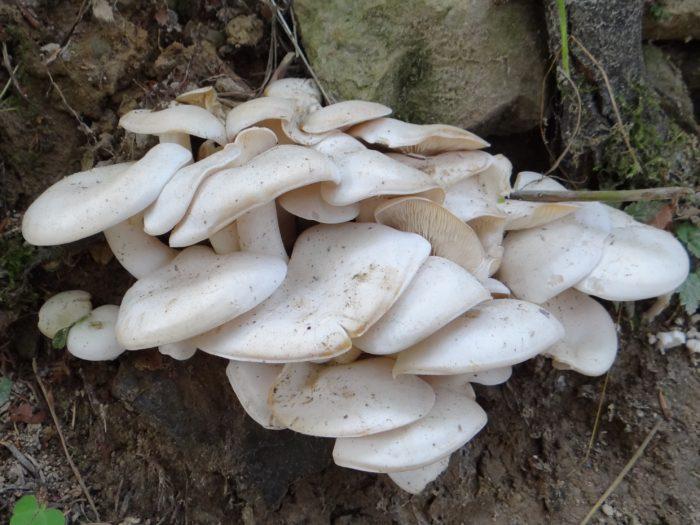
How to boil, marinate and pickle
In order to cook ryadovki, a simple recipe is used: pour 1 liter of water into a saucepan, add 30 grams of salt, a pinch of citric acid (to reveal the taste) and wait for it to boil. Add fruit bodies, stir and cook for 20 minutes, gradually adding seasonings. Suitable for rows: allspice, bay leaves, cloves. At the end of cooking, drain the water and continue cooking in another way, for example, marinate.
A container is prepared for marinating the row. This is usually a glass jar with an iron lid, which is used to pickle vegetables for the winter. Having doused with boiling water, boiled mushrooms are poured into it and a teaspoon of vinegar, the same amount of sugar, 6 black peppercorns, cloves and bay leaves are added. Then you need to cover the container with a lid and roll it up for the winter. In a closed jar, blanks are stored until next fall, and after opening for only a week.
For the winter, you can salt the row. Preparing again and pouring boiling water over the jar, put horseradish, 10 peppercorns and mushrooms on top, salt each new layer. Add garlic and roll up the jar. In a month and a half, the rows will be ready for serving.
Evaluation of taste, medicinal properties, benefits and possible harm
- Experienced mushroom pickers say that the taste of the rowers is rich and pleasant, but there are those who do not share this position. Still, the mushroom contains vitamins and has a number of beneficial properties: antiviral, antioxidant, anti-inflammatory.
- In medicine, row enzymes are used to create antibiotics against tuberculosis. The mushroom also helps with diabetes and hypertension, fatigue, weak brain activity.
- The substances contained in edible mushrooms have a beneficial effect on the entire human body and help the immune system to cope with diseases.
- The grown ryadovka is a low-calorie mushroom, but in terms of the composition of chemical elements it is similar to meat and can become its substitute in food. Because of this, it is consumed by vegetarians and recommended by nutritionists.
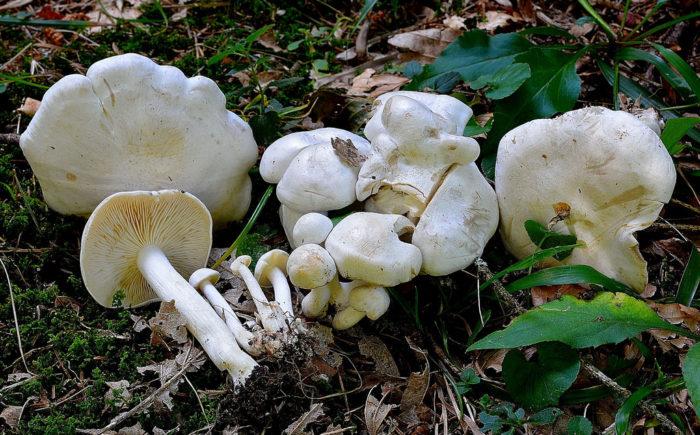
Characteristics of the fungus lyophyllum elm
Hat
- Advertising -
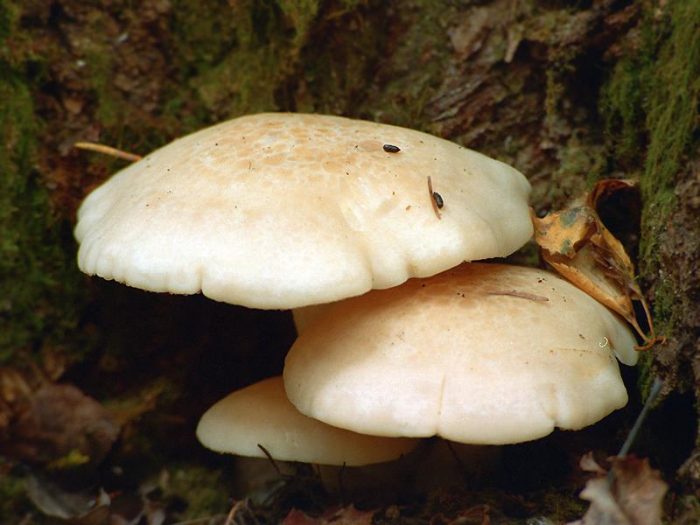
The cap of the mushroom is wide, 5-15 cm in diameter, sometimes up to 25 cm. The surface of the cap is dry, silky, decorated with a marble pattern, painted in a light gray or gray-ocher color. The shape of the cap in a young mushroom is convex, tuberous, the edge is curled up, with watery brown spots; with age, it gradually becomes convex-prostrate or prostrate, with a tubercle or depressed.
Pulp

The pulp is dense, elastic, fibrous structure, light or grayish-brown in color, the smell is weak, flour, the taste is pleasant, weakly expressed.
Leg
- Advertising -

The stem of the fungus has a fibrous structure, the color is whitish, pale fawn, with a light bloom, turns yellow from touch. The leg is 5-8 cm high, 1-1.5 cm thick. The structure is rigid, fibrous. Often three or more mushrooms grow together.
False doubles
The grown row is easy to confuse with other species of this family, if it is not enough to study. The danger is that you can accidentally stumble upon a poisonous mushroom, but mistake it for edible.To do this, you need to study the twins and compare the differences from the photo.
The main difference between the inedible fruit is a foul smell and an attractive curved cap. Consider the dangerous doubles of the row in the table.
| Name | The form | Color | Smell, taste |
White row |
Round-convex hat, dry | White, but turns yellow over time with brown spots | Musty smell, bitter, pungent taste |
Spruce row |
Small hat with a recess, round, thick curved leg | Brown | Unpleasant |
Soap row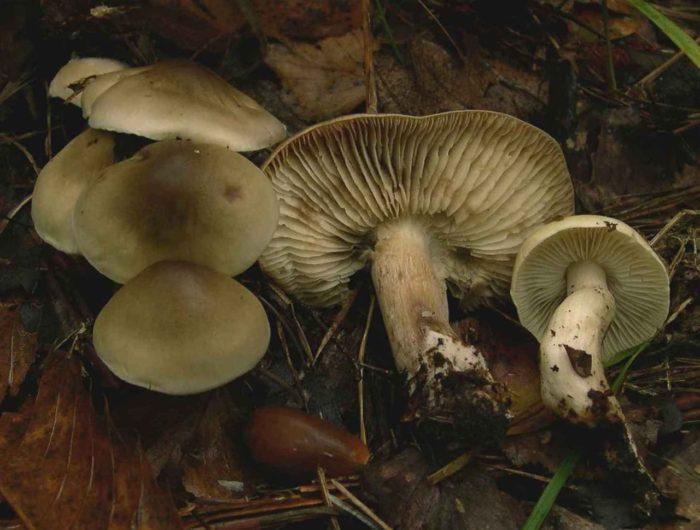 |
The hat is smooth, conical. | Olive color of the cap, lighter at the edges. | Fruity, soap-like odor, unpleasant taste |
Stinking ryadovka |
Convex head shape, curved leg | White with brown spots | Smells like gas, bitter taste |
Limacella sticky (Limacella glischra)
Synonyms:
Lepiota glischra

The sticky limacella leg covered with mucus will require a certain skill from the mushroom picker: the stem is so slippery with mucus that it is difficult to grab it with your fingers. Fortunately, it is the abundant mucus on the stalk, in addition to the reddish-brown cap, that is an important factor in identifying the species. The mucus can be wiped off, it is reddish-brownish, under it the leg is much lighter in color. The cap remains reddish brown after mucus removal, at least in the center.
Description
Hat: small, 2-3 centimeters in diameter, less often up to 4 centimeters, convex or nearly prostrate with a well-defined low central tubercle. The edge of the cap is very slightly curved, not striped or with implicit stripes in places, here and there, slightly convex, overhanging the ends of the plates by about 1 ± mm.
The flesh of the cap is white or whitish, with a dark line above the plates.
The surface of the cap in limacella is sticky and abundantly covered with mucus, especially in young mushrooms in wet weather. The mucus is transparent, reddish brown.
The skin of the cap under the mucus is pale brownish to reddish brown, darker in the center. Over time, the hat discolors a little, fades
Plates: loose or adherent with a tiny tooth, frequent. From white to pale yellowish, creamy color (with the exception of the areas that are sometimes monochromatic with the cap's mucus at the very edge of the cap). Seen from the side, pale and watery, as if soaked in water, or whitish at the margin and pale yellowish to pale reddish white around the context. Convex, 5 mm wide and of proportional thickness, with a slightly irregular wavy edge. The plates are of different sizes, very abundant and somewhat unevenly distributed.
Leg: 3-7 cm long and 2.5-6 mm thick, less often up to 1 cm. More or less even, central, cylindrical, sometimes slightly narrowed at the top.
Covered with reddish-brown sticky mucus, especially abundant below the annular zone, in the middle of the leg. There is almost no mucus above the annular zone. This mucus, or gluten, can often be patchy, streaky, later visible as reddish-brown fibrils.
Under the mucus, the surface is whitish, relatively smooth. The base of the peduncle is without thickening, light, often decorated with white mycelium filaments.
The pulp in the leg is firm, white, whitish below, above - with thin longitudinal watery veins, and sometimes with a reddish tint at the surface of the leg.

Ring: No pronounced ring. There is a mucous “annular zone” more clearly distinguishable in young fungi. In very young specimens, the plates are covered with a mucous transparent film.
Flesh: white, whitish. Color change in damaged areas is not described.
Smell and taste: mealy. A specialized site on amanite describes the smell in more detail: pharmacy, medicinal or slightly unpleasant, quite strong, especially the smell intensifies when the cap is "cleaned" (not specified, cleaned of mucus or skin).
Spore powder: White. Spores: (3.6) 3.9-4.6 (5.3) x 3.5-4.4 (5.0) microns, rounded or broadly ellipsoid, smooth, smooth, non-amyloid.
Ecology
Mycorrhizal or saprobic, grows alone or in small groups in forests of various types, under deciduous or coniferous trees. Very rare.
Season and distribution
Summer autumn.
There is no exact distribution data. It is known that confirmed finds of Limacella sticky were in North America.
Edibility
Unknown
No data on toxicity.
We will carefully place Limacella sticky in the category "Inedible mushrooms" and wait for reliable information on edibility.
Photo: Alexander.
Evaluation of taste, medicinal properties, benefits and possible harm
The mushroom is classified as a species with high palatability. It is recommended to use young fruit bodies for food after boiling for 20 minutes, and then subject to any type of processing: pickle, cook fried, salt.
Useful properties of crowded lyophillum:
- enhances immunity;
- cleanses the liver;
- lowers blood glucose levels;
- anti-inflammatory and antiviral action;
- B vitamins improve brain activity, increase efficiency;
- strengthens the walls of blood vessels.
It is forbidden to use ryadovki for children under 12 years of age, pregnant and lactating women, people with diseases of the gastrointestinal tract during exacerbations, with renal and hepatic insufficiency.
Primary processing and cooking recipes
Before harvesting or frying crowded lyophillum, you should first clean the fruit bodies of debris, cut them into pieces, if necessary, and then boil the mushrooms in a large amount of slightly salted water. The cooking time should be 15–20 minutes. The mushrooms are thrown into a colander, the liquid is allowed to drain and the heat treatment is continued.
Cooking
In order to properly prepare crowded rows, you should first boil them.
Ingredients:
- rows - 1 kg;
- salt - 1 tablespoon;
- water - 1 liter;
- citric acid - a pinch;
- black peppercorns - 6 pcs.;
- bay leaf - 1 pc .;
- dry cloves - 2 buds.
Cooking process:
- Clean the fruit bodies of sand and dirt.
- Remove damaged areas, discard rotten or wormy mushrooms. If the fruiting body is especially dirty, then you need to carefully peel off the skin with a knife.
- Rinse the fruit under running water.
- Pour cold water into a saucepan, add salt, citric acid, bring to a boil.
- Place the fruits in a bowl and cook for 20 minutes over medium heat.
- Add the spices 10 minutes after starting cooking. Boil for another 7-8 minutes.
- Throw the mushrooms in a colander, dry.
Pickling
Fragrant, tasty, crispy rows are easy to pickle for the winter. This does not require expensive components.
Ingredients for 1 kg of mushrooms:
- vinegar 6% - 90 ml;
- sugar - 1.5 tbsp. l .;
- peppercorns - 5 pcs.;
- salt - 1 tbsp. l .;
- bay leaf - 2 pcs.;
- cloves - 4 pcs.
Cooking method:
- Go through the fruits, leave only the most elastic for pickling. Cut large specimens, small ones - leave intact.
- Boil lyophillums in the traditional way with the addition of spices and salt, constantly skimming off the foam.
- Add vinegar, stir.
- Put the mushrooms in prepared, sterilized jars, fill with marinade. Roll up.
- Store canned food in a dark, cool place.
How to fry the rows deliciously?
This dish can harmoniously complement any side dish of vegetables, cereals, pasta, fried potatoes.
Ingredients:
- rows - 1 kg;
- onion - 2 heads;
- vegetable oil - 50 ml;
- salt, black pepper to taste.
Cooking method:
- Boil the mushrooms in the usual way in salted water. Throw in a colander, let the liquid drain.
- Heat sunflower oil in a frying pan, place the rows in it. Fry, stirring occasionally, for 10 minutes.
- Season with salt and pepper and cook for 2-3 minutes.
Salting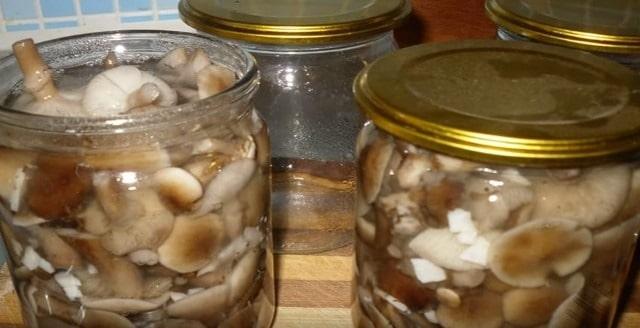
There are 2 ways to pickle mushrooms: hot and cold. With the first method, the rows will be ready in 7-10 days, and the second will provide a crispy, elastic structure of each mushroom.
Ingredients:
- boiled rows - 3 kg;
- table salt -5 tbsp. l .;
- bay leaf - 4 pcs.;
- dill (umbrellas) - 5 pcs.
Cooking method:
- Place the boiled fruit bodies in clean, dry jars with the caps down (the layer should be no more than 5–6 cm). Sprinkle each layer with salt and spices (by eye).
- Fill containers to the top. Place oppression on each of them.
- As soon as the fruiting bodies settle down, you can add a new layer of mushrooms.
- After 2-3 days, fill the contents of the jars with boiled cold water, close with nylon caps. Store in a cool, dark place.
Drying
This process does not take much effort from the hostess. You will need to clean the mushrooms, remove damaged areas, cut the rows into medium-sized pieces. Then place them on a baking sheet lined with parchment so that they do not touch each other. Place the future workpiece in the oven (the temperature in it should not exceed 50 ° C) for 1–2 hours. Stir the mushrooms periodically, check their readiness.
Store the workpiece in a glass jar in a dark, well-ventilated place.

